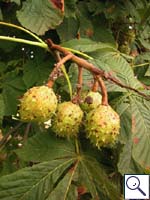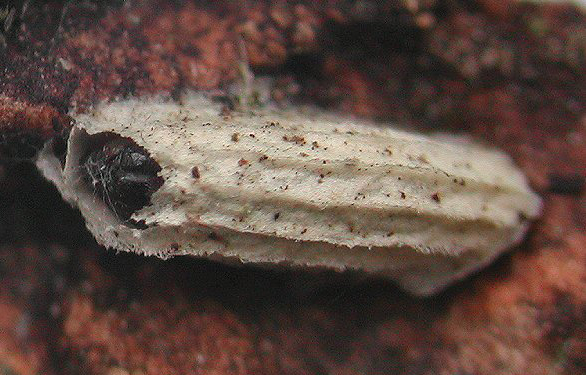|
||||||
|
AESCULUS. Horse-chesnuts. [Hippocastanaceae] |
|
|
Three species of Aesculus are recorded in Britain. All are aliens and include Horse-chestnut (A. hippocastanum). Three British miners are recorded on Aesculus. A key to the European miners recorded on Aesculus is provided in Bladmineerders van Europa.
|
 Horse-chestnut Aesculus hippocastanum |
|
Key for the identification of the known mines of British |
1a > Leaf-miner: The mine begins at a flat, oval, somewhat iridescent egg shell at the upperside of the leaf. The larva mines the leaves causing noticeable brown blotches, often many to one leaf. There is however, a similar-looking fungus which can cause confusion. The mine begins at a flat, oval, somewhat iridescent egg shell at the upperside of the leaf. There starts an epidermal corridor of some mm, that abruptly widens into an upper-surface blotch. The blotch is elongate, often confined between by a pair of lateral veins; its colour is cinnamon, with a darker centre. The frass is not granular, like in Phyllonorycter species, but consists of a tarlike substance covering the floor of the mine. The number of mines can be as much as several tens per leaf. Pupation occurs within the mine. The pupa and whitish silk cocoon are illustrated in British leafminers, UKMoths and the Encyclopedia of Life. |
|
Cameraria ohridella Deschka & Dimic, 1986 [Lepidoptera: Gracillariidae]. |
1b > Leaf-miner: The larvae mine the leaves at first, then create small feeding windows. Small, full depth, hook-like corridor, usually in a vein axil, with a proportionally large larval chamber. The remainder of the mine almost entirely stuffed with frass. At the start if the mine an iridescent egg shell. The larvae soon leave their mine and start living free on the leaf. The pupa and white ribbed cocoon are illustrated in British leafminers. |
 Bucculatrix thoracella cocoon Image: Rob Edmunds (British leafminers) |
|
Bucculatrix thoracella (Thunberg, 1794) [Lepidoptera: Bucculatricidae]. |
1c > Leaf-miner: In the first instar the larva mines the leaves, forming short, irregular, blotch-like mines, but in later instars it lives externally, feeding in spun leaves and often twisting those of tender shoots. Larval head light-brown or yellowish brown, edged with black postero-laterally, ocellar area blackish; prothoracic plate black edged with whitish anteriorly; abdomen dull dark green; pinacula distinct, black, sometimes brownish but with black bases to setae; anal plate large, black (Bradley et al., 1973). Small, full depth mine without a definite shape; little frass. Some silk is deposited in the mine. The larva soon leaves the mine and continues feeding among spun leaves. |
|
Cnephasia incertana (Treitschke, 1835) [Lepidoptera: Tortricidae]. |
| Last updated 30-Jun-2019 Brian Pitkin | ||
